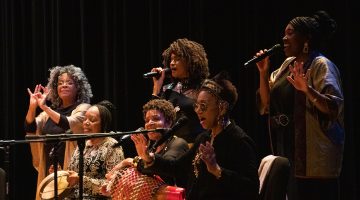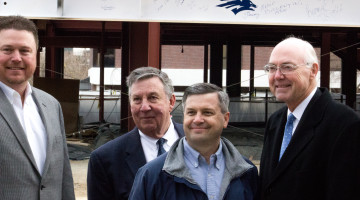
President Marc Johnson speaks at UNR’s historic Lincoln Hall on Thursday, Oct. 6. The building was reopened after being renovated and converted into office space.
Lincoln Hall, a 120-year-old all-male dormitory at the University of Nevada, Ren,o has undergone structural-design changes that began last December. The newly restored hall has been reopened to the public as a space for faculty offices.
Lincoln Hall, named for Abraham Lincoln, was originally built in 1896 and served as the first all-male dormitory at UNR. The dormitory is one of 13 buildings on the National Register of Historic Places on campus and before its closure was the oldest continuously operating residency hall in the Western United States.
UNR currently enrolls over 21,000 students and is planning to expand the number of faculty. The renovation and restoration provides much-needed office space for the growing university.
The old dormitory was closed in May 2015 due to safety concerns following more than a century of use.
The $8.5 million project to restore the hall began in December. The project followed a strict schedule and was completed on time.
The reopening ceremony took place Thursday, Oct. 6, in front of the renovated hall. The ceremony was led by Dean of Liberal Arts Debra Moddelmog. President Marc Johnson, Reno City Councilman David Bobzien, past residents of Lincoln Hall and members of the community were also present.
The reopening ceremony highlighted the university’s goal to stay in touch with and honor its history while striving to be one of the top schools in the country.
Johnson explained the importance of maintaining the history of the building while meeting the need for restoration and transformation.
Some major improvements to the buildings include air conditioning, along with updating the building to be fully compliant with the Americans with Disabilities Act. Other changes include structural-design upgrades and the addition of both male and female bathrooms.
“It’s gratifying to see the plan coming to fruition,” Johnson said.
John Walsh, Facility Services project manager, explained the need for the restoration was to keep the people in the building and those around it safe during an earthquake. Before the refitting, during a large enough earthquake it would have been possible for the floor and ceilings to separate, causing the building to collapse.
“The historic value was worth the money,” Walsh said.
In addition to upgrading and adapting the building to meet needs of the growing student body, the university has kept the history of the building intact. The windows, the arch and the chimney have been reinforced and are part of the “Eclectic” architecture style that the university was originally modeled after. Inside the building, a tabletop is mounted on the wall that has the names of prior residents carved into it, paying homage to the history of the residency hall.
A major reason these seismic retrofittings need to take place is to protect the Nevada economy. Graham Kent, director of the Nevada Seismological Laboratory, emphasized the importance of “economic resiliency” for Nevada. Kent concluded that updating these buildings not only saves lives but also helps the Reno economy. If buildings are unable to withstand earthquakes and collapse, the cost of the clean-up and the loss of the inventory inside could be immense. A proactive approach to these issues could prevent these costly consequences later on. He encourages Reno businesses to look into seismic retrofitting to protect their investments.
This project is not the last of the restorations being done at the university. Lincoln Hall was the first project to be finished, but other buildings, the Manzanita dormitory and the Palmer building among them, are part of the $26 million renovation plan.
“This is the first step of many, possibly thousands,” Kent said.
William Yepez can be reached at rspacek@sagebrush.unr.edu and on Twitter @TheSagebrush.












